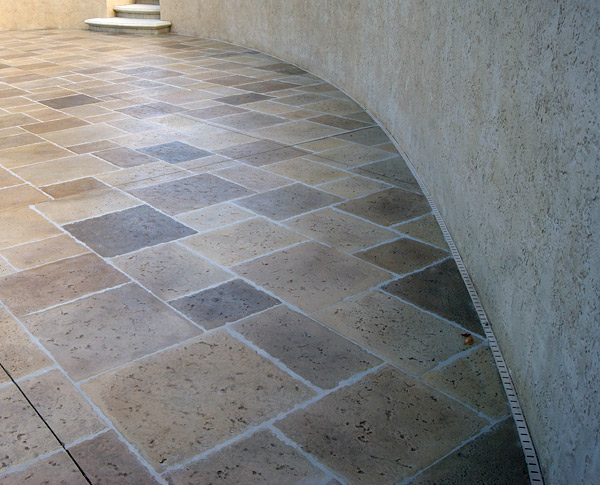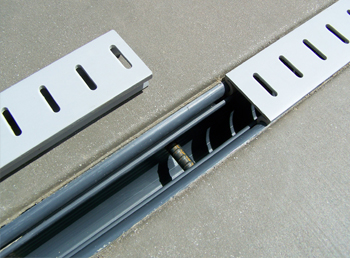In recent years the popularity of salt-water pools has skyrocketed, because salt water has a softer feel, is gentler on the eyes and skin, is safer than chlorine, needs less maintenance and is lower in cost than chlorine. I chose salt water for my pool and I love it. I occasionally dump in a couple of bags of salt and the water is good for a long time. However, for those of us putting down sealer on concrete decks, salt can be a nightmare. It’s common knowledge that salt is one of concrete’s worst enemies. You’ll need to understand the pros and cons of the different deck sealer options and how effective they are on salt-water pool decks.
Salt-water pools
There are two basic types of sealers: topical and penetrating. Topical sealers are generally solvent-based acrylic sealers that enhance the color. Most people want topical sealers and they look great at first. Most of these sealers are breathable, which means they let moisture through from underneath, but they also let it come through from the top. If you were to put water on top of these sealers and let it set for an hour before wiping it off, the color would be noticeably darker in that area. Adding salt to the water means you end up with some actually under your sealer. This can contribute to the sealer flaking, especially in high-traffic areas.
A third option has been garnering more attention. Many manufacturers have developed a hybrid type of sealer that combines topical and penetrating properties into one product. This type of sealer blocks out water very well. We have tested this numerous times by letting a puddle of water sit overnight on a piece of concrete sealed with this type of sealer. We have seen no dark spots where the water sat. If water can’t get in, the hybrid won’t peel off. Hybrids enhance the color but are not as glossy as a straight solvent-based topical.Penetrating sealers do not enhance the color of the concrete like topical sealers. They seal the surface from the inside out and leave no topical film. That means there is nothing that can flake off. Penetrating sealers are far less maintenance and are actually better for the concrete over time. However, most people still want the color enhanced and their concrete to shine.
These hybrids typically have a much lower viscosity that allows for better penetration into the concrete. The drawback is you are again putting a topical film on the surface, so slip-resistance is a concern. In my opinion, if you’re going to have any kind of salt on your concrete, whether from pool water or de-icing salts, some type of penetrating sealer should be used. They just protect it better.
Anti-slip additives
Is stamped concrete slippery? That is the question I get most often. The answer is yes, especially where there is constant water, like around a swimming pool. You can buy polypropylene additives that you mix into your sealer that do an OK job. But, around a pool, people want something safer. A 40-mesh aluminum oxide works best. However, it is heavy and doesn’t stay suspended in the sealer. You must broadcast it on, which is hard to do by hand, and usually ends up uneven.
you can achieve best results using a hopper gun, like you would use for spray textures or GFRC (glass fiber reinforced concrete) mixes, to broadcast the aluminum oxide. Have one person spray the sealer and another one very lightly spray the anti-slip out of the hopper gun. Immediately back roll to even it out. This has proven the most effective method I have found to get the right amount of slip-resistance. We’ve never had a callback with this process. The surface feels like 80-grit sandpaper on your feet. You do lose a little shine with this method — a small price to pay if the homeowners don’t want people falling down.
Deck drains
What should you do to control rainwater runoff on a pool deck? In a typical scenario the pool company doesn’t want the water running back into the pool. The house already h as a patio that slopes away from it and will be meeting up to the new pool deck. Many times homes are sited so close together that the water could easily run over to someone else’s property.
as a patio that slopes away from it and will be meeting up to the new pool deck. Many times homes are sited so close together that the water could easily run over to someone else’s property.
One option is to place a big, ugly drain for the water, but I’ve always hated having valleys in the middle of the deck. It certainly doesn’t look nice and makes an awkward place to set anything. I always try to slope the concrete all in one plane, then place a streamlined deck drain at the end of the deck.
Typically these drains are only 1 1/2 inches wide by 8 feet long and come in white, tan or gray. Some customers paint them to match their patio.
In situations where the concrete deck ends into a masonry wall, we glue the drain to the wall then pour against it. If your goal is to avoid dumping excess water on someone else’s property, wait until the concrete is poured. Once the concrete has hardened you can glue the drain to the concrete.
The best part about these types of drains is the design. They are flat on one side and round on the other and use standard 1 1/2-inch PVC fittings, pipe and glue. There are also prefabricated corner pieces as well as bottom drain-outs that can be connected to larger underground drain lines. This type of drain system is aesthetically pleasing, will handle a lot of water, is easy to install and is very cost-effective.
This type of drain system is aesthetically pleasing, will handle a lot of water, is easy to install and is very cost-effective.
credit to
water shape magazine
pool and spa professional magazine
pool patio website